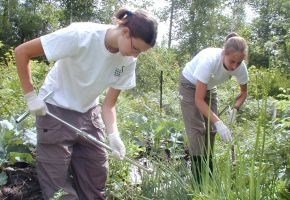Community activists recommend expansion of study to properly assess community risk
Some Greater Sudbury residents are reacting to the results of the Sudbury Soil Study.
Residents attending the public information sessions in Copper Cliff Wednesday expressed concern and they were unhappy that the consultants investigating the toxicity of the soil, water, air and local wild foods did not consider the historical exposure of people to metals such as nickel and lead.
 Homer Seguin, retired health and safety expert and former Local 6500 union president, attended the first information session, at Science North Tuesday and made a number of recommendations.
Homer Seguin, retired health and safety expert and former Local 6500 union president, attended the first information session, at Science North Tuesday and made a number of recommendations.
“What people want to know is, was this a safe community to live in for me, not just is it a safe community today,” he said.
Seguin said that, while he appreciated the dedication and expertise of Chris Wren's SARA Group (the consultants who did the research), he believed the original terms of reference of the study were flawed.
“The technical committee which provided the terms of reference did not ask the SARA Group to look at the effects that past exposure might complicate the health of those exposed to current levels,” said Seguin.
The 10,000 retired mine workers got a much bigger dose than the general population and this exposure will affect their ability to handle the current exposure, he said.
“The current level of exposure may be a problem for those with past exposures, even those who were merely residents and not mine workers. So the equation should be this: Past exposure plus current exposure plus expected future exposure to calculate the overall risk,” he said.
However, a number of toxicologists including Ronald Brecher, from Guelph, and Elliot Sigal from Mississauga, both said it is very difficult to accurately measure the effects of past toxic loading from chemicals in the body.
“Taking blood samples only measures current exposure rates,” said Brecher.
Doctor Penny Sutcliffe, Medical Officer of Health for Sudbury and District, said this study was not a health study but risk assessment which is different. If people have health concerns, they should consult their doctor and take advantage of information supplied by the Health Unit to lessen their risk of exposure.
Local 598 CAW president Rick Grylls has lived in Falconbridge for years and has observer status on the technical committee of the Sudbury Soil Study.
“We did suggest they look at past exposure but that was not followed,” said Grylls at the Falconbridge session Thursday afternoon.
Seguin refuted SARA's claim that there was not sufficient data available to undertake research in this area.
“We know how much emissions the smelters put out historically and I am aware of many studies that did look at soils and water samples in the past, enough to be useful.”
Another glaring omission is that the study is not considering the loading effect of toxins from the female toddler (identified by the study as being most at risk) who might work for the mining companies 20 years in the future, noted Seguin.
You cannot isolate the community from the emitters, he said.
The fact that the study set the acceptable limit for lead at 400 parts per million (ppm) when the federal acceptable limits are 140 ppm and the Ontario acceptable limits are 200 is also questionable, he said.
“I do not buy the SARA argument that 400 ppm for lead is acceptable for this city because it is a site-specific measure when it is not acceptable for the whole province. (Is Sudbury) not in Ontario?”
However MOE officials said the 200 and 400 ppm levels are only guidelines. When samples indicate they are higher then that indicates more investigative work has to be done.
“It is a red flag that prompts more analysis, said Brian Cameron, Sudbury district manager for the Ministry of Environment.
Seguin stated there should be more samples taken, especially in areas where there are higher than the regulated levels of lead.
“If more samples were taken and the provincial benchmark of 200 ppm for lead were used, then there would be hundreds of homes with possible risks of exposure,” he said.
Chris Wren, director of the SARA Group of consultants, doing the investigative scientific work, has countered that the study focused on current exposure and that occupational health and safety issues were the jurisdiction of the Ontario Ministry of Labour, and therefore were not part of the mandate of this study. He also has questioned the rigor of past studies considering the science used is much more accurate today.
One participant asked why the comments by Homer Seguin, made in the Science North session Tuesday could not be made available to the public. He was answered by Stephen Monet, a city of Greater Sudbury environmental manager, that the sessions were taped and that was a possibility. Residents can visit all local libraries including those in post secondary institutions to view the full report or download it from www.sudburysoilsstudy.com.
